So, a quick disclaimer, and, as per tradition, a short personal story and a lesson I experienced. You may jump to the next section directly, where I explain my paper in my signature, laid-back way.
Here goes; for the people who think that the combination of a full-time job and a full-time master’s is viable – please don’t.
It was an experience that I wouldn’t like to repeat. Dedication to finish this, a lot of help and understanding from my colleagues, professors & peers, and, to be frank, pure stubbornness that this is fine, just made me push through. Oh, and staying inside with nothing else to do due to the pandemic was “helpful” as well!
:format(jpeg)/cdn.vox-cdn.com/uploads/chorus_image/image/49493993/this-is-fine.0.jpg)
I wish I didn’t. But ultimately, I am glad I did.
It was a great side quest for me. A very rewarding one. Through courses, coursework, and discussions, I earned the greatest gift of all – knowledge. And, hey, I did a Thesis too!
The following article is an effort to convey the results of my dissertation in a compact, easy-to-digest, and friendly-to-read way. For a more in-depth view, I do suggest you check the whole research paper, as it goes (naturally) into extreme detail.
- Find the whole paper by clicking here
- Find the thesis presentation by clicking here
Now, with all the links settled; let’s get this started!
Table of Contents
Branding Fundamentals
Skip this part if you know about branding. Or not, actually, I ain’t your boss.
Brands, huh?
It’s no secret that brands and branding have played a pivotal role in business from as early as the past century. And even before that!
Why do brands matter? Stop for a brief second and think of random brands that you have interacted with the previous days. Find one that you adore and one that you detest.
Ready? Perfect!
It’s a fact that we, people, are biased creatures. To help speed things up in our limited brain, we have to make lots of compromises. One of which is to make associations of specific characteristics to other entities, to help in our decision process.
We all do this with people. For example, that’s why first impressions matter so much, with the rule of thumb being that we can take as little as seven seconds to form an opinion about someone we meet for the first time. Once these characteristics are associated with this specific individual, the game’s almost over. Like a ship’s in unfortunate currents, it’s very hard to turn the wheel to safe water. That ship was sailed!

Back to our main conversation topic, though. We do the same thing with brands, in a sense. Think of the two brands you chose; you love and hate them for specific reasons.
Maybe the first one makes you feel welcomed or valued. Maybe you even chose a small brand; your favorite, cozy café place, that you go to study, with their amazing hot chocolates that make you happy!
Possibly, you had a bad experience with the second one. Could it be that the staff of a clothing shop mistreated you? Or a salesman deceived you into the wrong choice?
Ultimately, a brand is a promise; You go to KFC to get golden, finger-licking fried chicken, and you know that you are supposed to get the same thing over and over. You can’t get the same thing to other food joints; it’s not like they are bad or something, it’s just that they are not KFC!
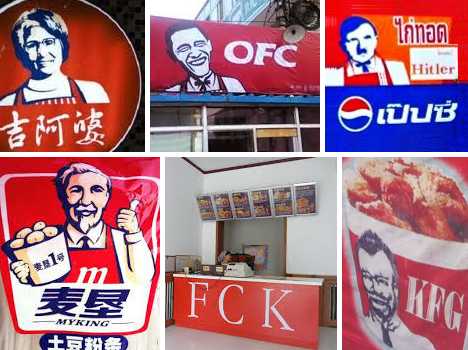
And this promise helps us, the consumers, make our consumer decisions easier. Like we mentally categorize people, we categorize brands too.
Equally importantly, it allows companies to differentiate from the competition. In this strongly competitive market, price and quality are not enough reasons to stay apart. You need branding for that.
Example: Want to get cheap flights? We go to Ryanair’s dirt-cheap prices. Anyone who thinks that it will be treated like royalty in such a flight should be treated as delusional. Even Ryanair’s branding efforts have been crystal clear that you can’t get these prices without quality cuts. Their branding case is super interesting, but it’s a branding topic for another time (probably for my next post, too).
How a brand is shaped, then? As briefly as possible, by two, equally important components. The first one is what the brand does for itself; all the branding actions to try and establish itself as it is aimed. The second one, however, is how the stakeholders view the brand; its brand image. And you have to nail both of them to succeed in branding.
Anyway, thing is, that a brand is a promise. But a promise isn’t as strong every time, right? This is where brand trust comes into play, as it’s one of its important assets. You can try and show off whatever you want; but if people do not believe in that, It all comes crashing down.
That’s good enough for your understanding (I hope). Let’s proceed with my paper!
Brand as a Human Being: Jennifer Aaker’s Dimensions of Brand Personality
I couldn’t escape theory for long, people. I am sorry. But I will make it as consumable as possible.
Just before, I talked about how we make specific associations to humans we meet for the first time. What if I told you we treat brands as humans, too?
Crazy talk, you might say. But think of it! Doesn’t Nike remind you of someone dynamic, athletic, impulsive, who likes challenges, while Coca-Cola could be a friendly and people-centered person, who likes to spend sweet, warm moments with others close to him?
These characteristics we associate with brands have been reviewed a lot by both academia and business, bringing us to the work of Jennifer Aaker (1997). Her “dimensions of brand personality” paper created a model to measure the “big five” dimensions for brand personalities, similarly to the big five dimensions used to conceptualize human identities. This model included 42 characteristics that can be categorized into the following big five dimensions: Sincerity, Excitement, Competence, Sophistication, and Ruggedness.
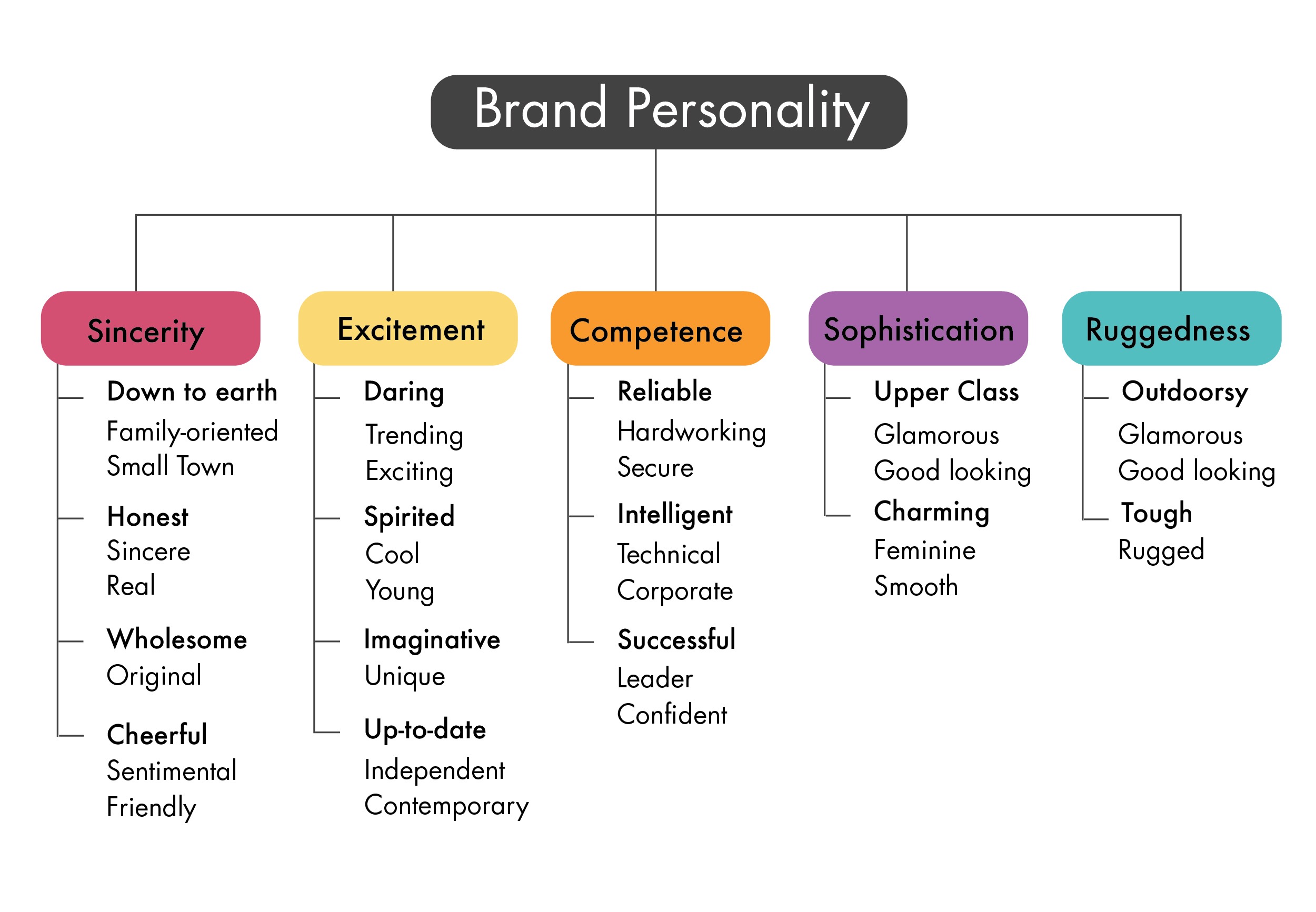
Many of these characteristics should ring a bell for humans as well, don’t they?
But, this is only one way of looking at things. Kapferer, a master of branding in academia, strongly opposes J. Aaker’s model, and probably rightfully so, to an extent. Kapferer’s identity prism (seen below) is a thorough model to look at brand identity, so I suggest you have a look at it if you want to learn more about the magical world of branding.

And while I do agree that Kapferer’s identity prism is spot on, J. Aaker’s model provides an excellent model for companies to think about how they want to behave to the outside world.
What’s a great brand personality looks like? The short answer is that there is no panacea here. You have to find the right one for your business.
In my findings (see below), I found out that high-class and honesty don’t go along. Would that mean that trying to create a high-class brand is wrong? Of course not. It’s all about what’s your offerings and your target audience. It’s all about that brand promise, people! If you are Luis Vuitton, creating luxurious bags, being high-class is a priority. High-class’ your thing.
But, from all the personality traits, why did I focus my paper on honesty?
A Word about Brand Honesty: Personal Motivations for the Dissertation
Well, because it was my paper and I do what I want, silly!
Okay, not (only) that.
I determined brand honesty as “a brand’s effort to collectively act based on the principle of honesty”, and I centered my dissertation on brand honesty because, in many cultures, the business world is viewed as the exact opposite of honesty. It is a world full of scandals, mistreatments, and many social problems.
And I am sick of it! There, I said it!
I try to stay as honest as possible, and if I would like to leave my mark for something in this business world, is to try and make it as open and transparent as possible.
And it could even make economical sense for brands to do so. Look at how sustainable brands are favorably treated. A considerable share of customers appears to condone paying a premium for products marketed as sustainable, in various sectors (Harris, 2007) (Sellers, 2016).
Which led me to my thesis. Did I do a good job? See for yourself below!
Paper’s Hypotheses
I took all these aspects and tried to apply them for brand honesty. I tried to answer the following hypotheses and gathered data from the public to see if they would make sense.
So, which were the answers to these hypotheses? Let’s check them, one by one.
Brand honesty is not solely associated with sincere dimensions of brand personality
Based on Aaker’s (1997) model; 41 dimensions were used, to find correlations with honesty.
In essence, I was asking a simple question, 41 times (I am pretty sure all respondents hated me for that, so sorry); Do you think characteristic x is associated with honesty? The detailed results from the sample were the following:
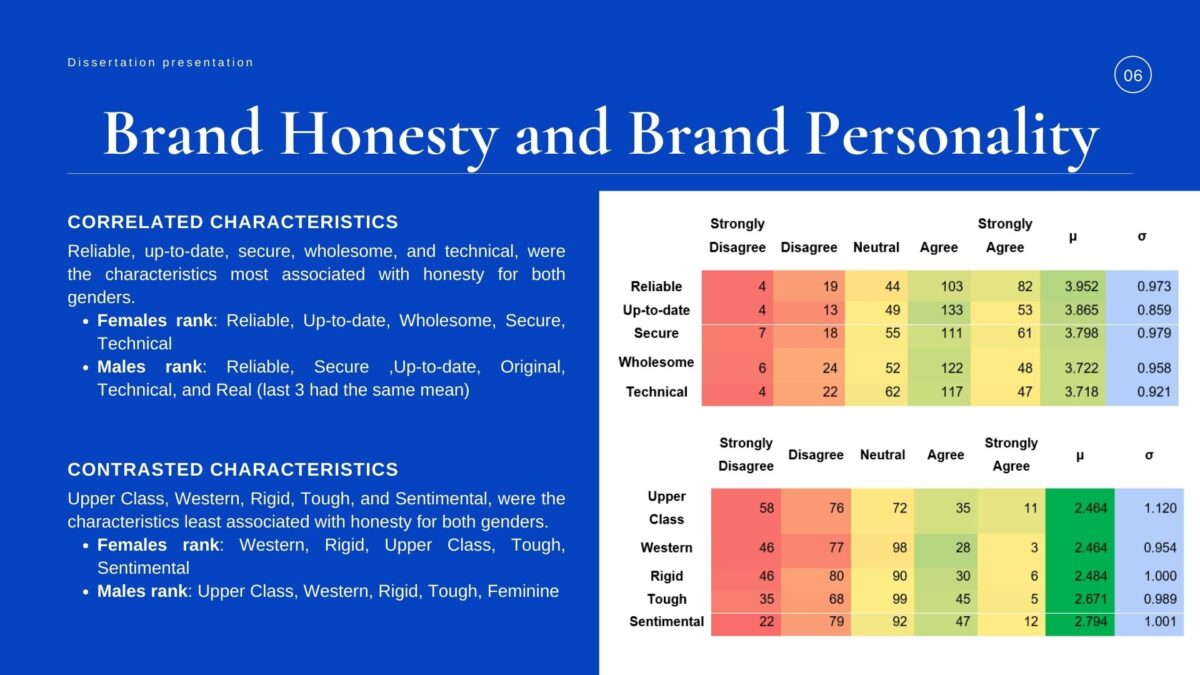
I will shamelessly use my slides, yes. No, I won’t do the credits. Yes, I won’t credit myself.
Sincere characteristics were, indeed, important in a brand’s pursuit to appear as honest. Of course, excluding sentimentality, which was counter-productive in this case.
But they weren’t the only, neither the most crucial on the matter! Reliability, a characteristic that will appear again as we progress within this article, was the top performer; to be honest, you have to be reliable. This was the clear outcome for both Females and Males. Being up-to-date, secure, and technical, traits that are all under the “competence” personality category, also appeared to have a strong correlation with honesty.
Of course, there should be things to avoid. No hard feelings, but to appear as honest, having a hard, tough, or rigid brand won’t do. The same goes for western (sorry Malboro) and upper-class traits.
Specific business activities are connected with brand honesty
There’re some insights for who to be; what about what to do?
In theory, conscious customers will expect specific actions to understand if a brand can be considered as honest. So I tested the sample on 15 different positive actions, to see which ones were the most effective in conveying honesty to the public.

To summarize, Communications Practices, Crisis Management, and Human Resources Practices actions were among the ones mostly correlated with honesty, while Digital Marketing Practices actions were the least correlated ones.
The clearest outcome that emerged was that respondents valued actions as honest when actions are meaningful to their respective receivers (ex. maintaining the maximum degree of transparency to stakeholders was the highest scoring answer). The opposite is true as well (ex. sharing of financial statements to the general public was the action with the lowest score).
To be self-critical of my work, I can admit that this hypothesis was, indeed, the weakest of the bunch. In retrospect, a mixture of positive and negative actions should have been used to measure how honest or dishonest each one is.
But here’s a good time to say that I reviewed the one side of the coin only; so, as an easter egg, if you read these lines and they inspire you to review dishonesty in branding, hit me up to help you with your research!
Anyway, moving on to the next hypothesis.
Brand honesty has a prevalently positive effect on brand trust
Previous models do show a correlation of brand honesty with brand trust, but how important is it?
The paper tries to create a proto-model by combining various brand trust factors from other papers, leading up to the inclusion of 7 characteristics: Reliability, Security, Honesty, Open & Sincere Communication, Shared Values, Privacy, Altruistic Behavior.
As these traits are already proven to drive brand trust, all research was focused on finding which ones are primary or secondary for brand trust. The results are the below:
- Primary Attributes: Reliability, Security, Honesty, Open & Sincere Communication
- Secondary Attributes: Shared Values, Privacy, Altruistic Behavior
To cultivate brand trust, a brand should focus on being reliable, honest, and communicate openly and sincerely with stakeholders. The security aspect especially, which was the second favorable attribute, seems like an outcome of the digital era we currently live in. Shared Values, Privacy, and Altruistic Behavior, are still important, but in a secondary manner.
Brand honesty makes customers willingly pay more for an honest brand’s products or services
It’s all about profits in the end, no?
As I would like to disagree here, a company that is not profitable will be quickly wiped out of the map. It’s just business.
This shouldn’t be characterized as evil and vile; in the same fashion as sustainable products, being a good member of society should be actively rewarded. So the questions here were simple:
Would you pay a premium for a brand’s offerings, if you knew that
- A brand is honest (Brand Honesty)?
- A brand is trustworthy (Brand Trust)?
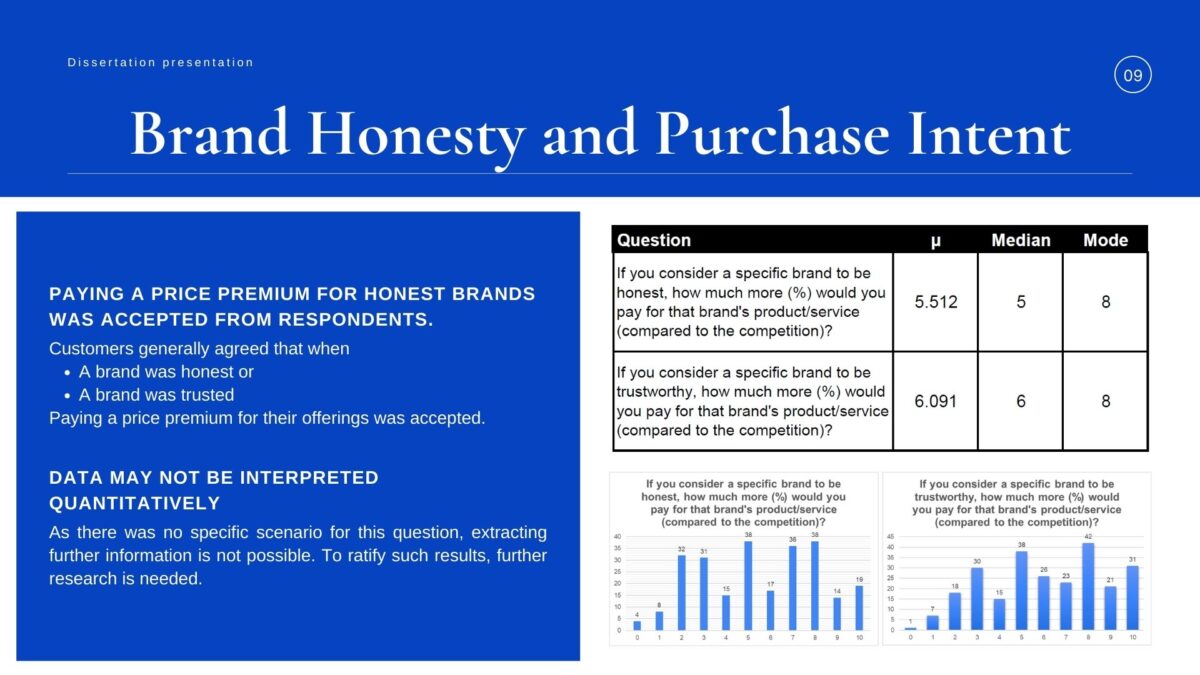
As you will see, the respondents have to reply about how much more (%) they were eager to pay in these two scenarios. But the data should not be taken into account, per se. In similar papers concerning paying a premium for sustainable products, they were always centered around a specific market (e.x. wines in Sellers, 2016 work), so that the customers had a sense of how much a specific offering costs.
In this case, the sample was left without a specific product or service, so they had to arbitrarily think of a market for themselves. Nevertheless, the intent was to measure if consumers wanted to pay a premium, and, if so, how different this intention will be for brand trust in general.
With this in mind, it is easily interpreted that both brand trust and brand honesty are rewarding for a brand.
Brand honesty has positive effects on Word-of-Mouth (WoM) and on the brand’s offerings perception
And, except for the price, what else could be rewarding for an honest brand?
It became super obvious about one thing; an honest brand can be super popular about it!
Look at what Fairphone’s been doing, for example. Fairphone is on a mission to bring sustainability to the smartphone world, by creating extremely repairable and upgradeable devices, taking care to have a fair, sustainable supply chain in all of its stages.
And they are getting so much publicity for it. Rightfully so! They will never be the greatest smartphone brand, nor the most cutting edge one. Instead, it’s a banner of hope and change for a very unfair and dirty technological world, and it’s getting the right amount of WoM from it.
So would that happen with honest brands, as well?
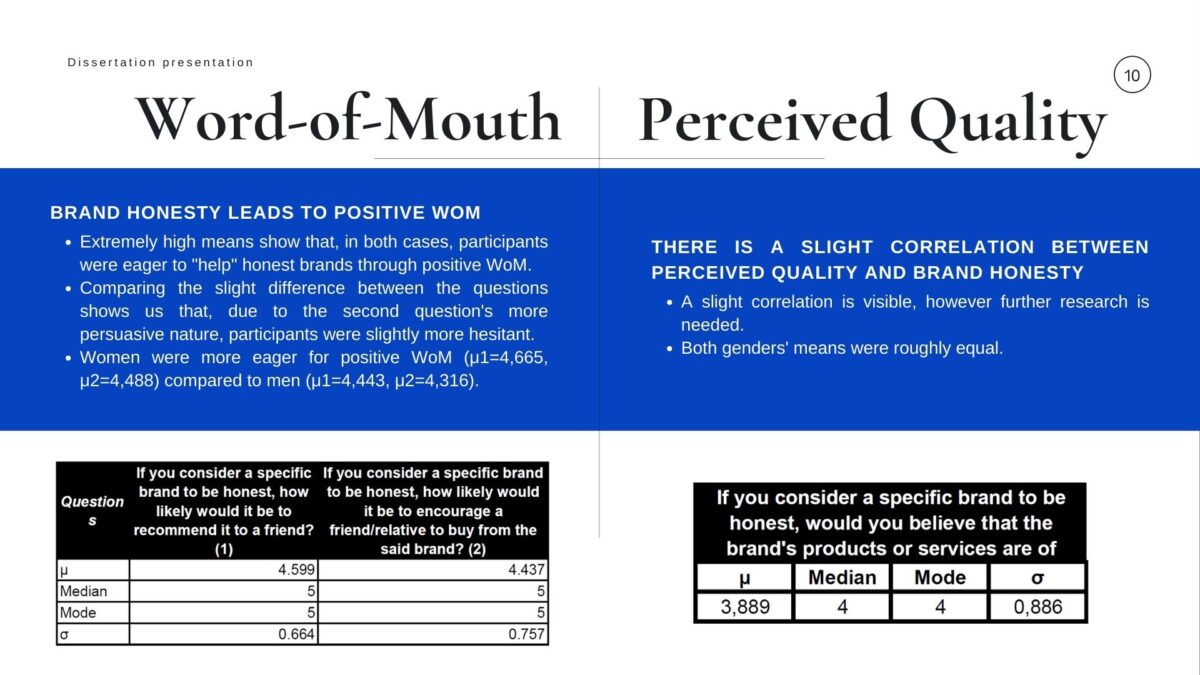
The answer is… yes. And this was clear as day.
This wasn’t the case for a correlation between perceived quality and brand honesty, however. The results here were flimsy, so further research is needed here; and talking about further research…
Words about the Sample, the Limitations, and Further Research
This research wasn’t perfect, of course.
When gathering data, I was searching for Greeks aged from 20 to 39 years of age. I decided to focus on this group as it’s tech-savvy enough, while starting having their own income to spend, and their own consumer voice. Extreme care was taken to keep the sample’s quality at the maximum, leading to 252 valid responses.
The sample’s distribution was satisfactory in all cases but gender. No matter how much I tried, gathering data from males in a random, correct sampling-respecting way, was so much harder. And this lead to threats and opportunities; all data was analyzed gender-wise, and many differences did arise. I go into further detail both about the sampling method and further limitations and additional analyses within my paper (if you are into that).
Of course, let’s not forget the cultural impact; all respondents were predominantly Greek; there were measures to ratify that they were living in Greece recently enough, ensuring cultural harmonization. This means that all results won’t be the same for other cultures (for a comedic example, in the wild west, being Western could even mean that you are being honest!).
So, yes, there will be flaws. I know many of them. I knew them even when I was writing my paper!
But this means that you can jump in! If you want to have some ideas for your research, well, here goes:
- Additional research on brand honesty specialized to specific business areas researches and/or focused on specific demographic groups.
- Research on characteristics and actions negatively affecting brand honesty.
- Development of new brand trust models, taking into consideration the findings of this paper.
Summing It Up
Writing a thesis is an extremely rewarding journey.
Were there moments that I wanted to go to the heck of it? Sure. Many ones!
But many people kept pushing me! I thank my supervisor, Dr. Eleni Mavragani, for her exceptional help along the way, my closest friends and family for listening to me rant about it for many months, and my classmate Anna for convincing me not to ask for an extension, in one extremely moody day that I just wanted to give up. Thank you all, kindly!
And for a sum up of my research, find my final slide below!
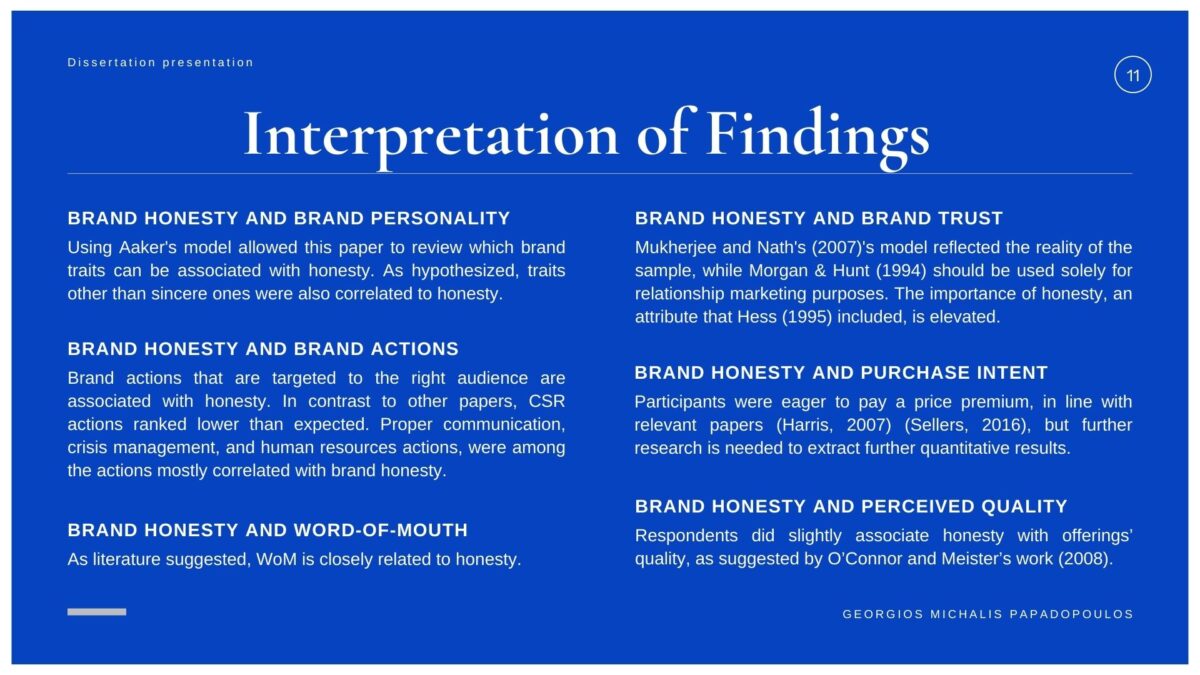
Thank you for sticking up with this! There are other interesting things to read here, and if you are so invested in branding to read the whole thing, why don’t you read my blog post about a flaw in Mercedes’ brand?
Oh, and for any comments, feedback, and everything in between, feel free to reach me on LinkedIn!
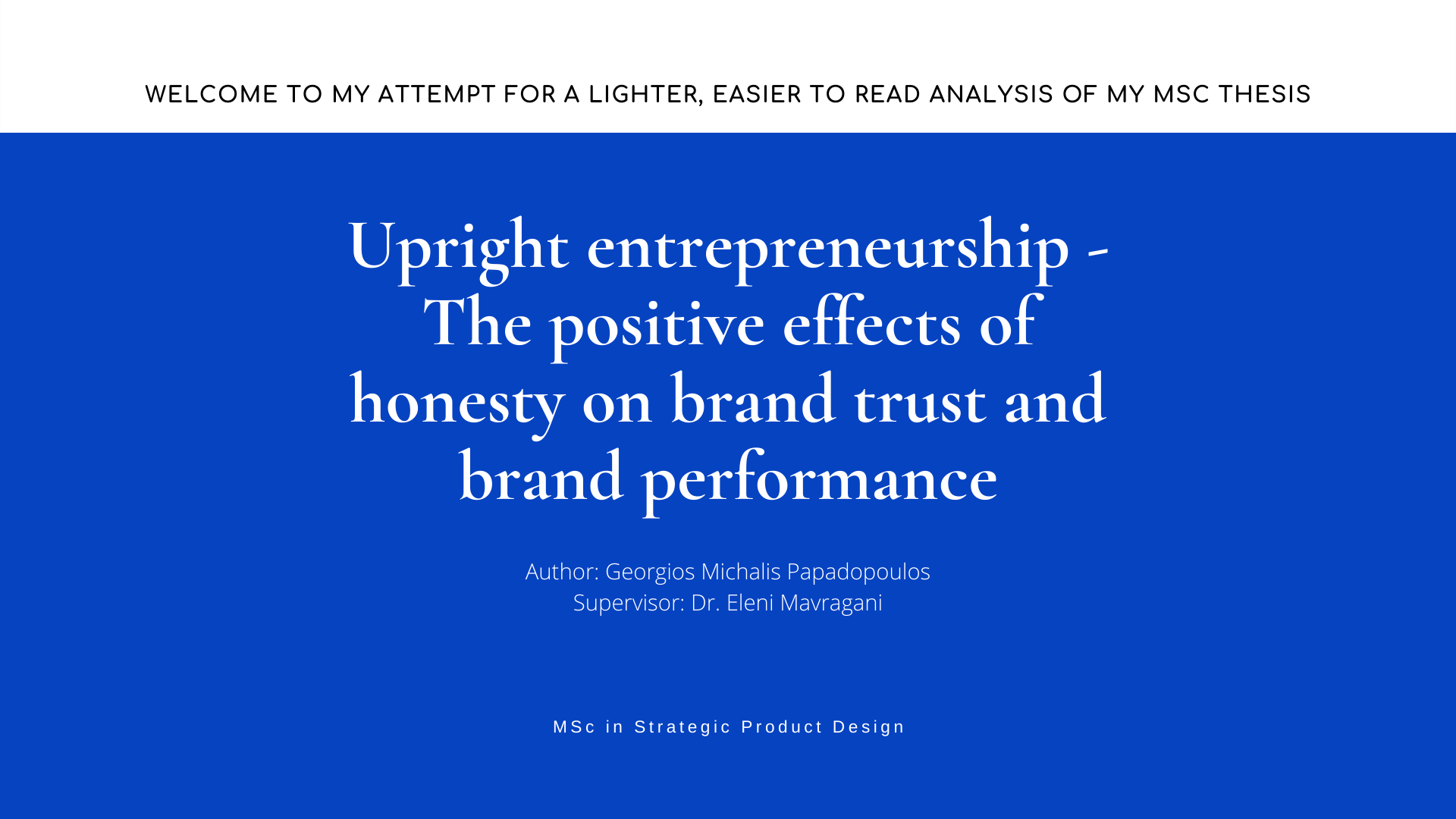
Comments are closed.